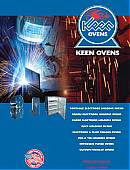Industrial Ovens
Front-Loading
![]() Under 10 cubic feet
Under 10 cubic feet
![]() 10-20 cubic feet
10-20 cubic feet
![]() Over 20 cubic feet
Over 20 cubic feet
![]() See All
See All
Top-Loading
![]() Under 10 cubic feet
Under 10 cubic feet
![]() 10-20 cubic feet
10-20 cubic feet
![]() Over 20 cubic feet
Over 20 cubic feet
![]() See All
See All
Learn About Our Industrial Ovens
Welding Ovens
![]() CONEX Storage
CONEX Storage
![]() Stick Electrodes
Stick Electrodes
![]() Sub-Arc Flux
Sub-Arc Flux
![]() Wire Spools
Wire Spools
![]() Tig Filler Wire
Tig Filler Wire
![]() Multi-Purpose
Multi-Purpose
![]() Nitrogen Purge
Nitrogen Purge
![]() See All
See All
 Order Our Free Catalog Today Click Here |
| Available Inventory |
Heat Treating In WeldingI tell my students what they learn in my welding classes is the tip of the iceberg when it comes to knowledge of the welding trade. And when I say tip, I mean a very small tip at that. Some people think of the welding trade as some guy standing there all dirty with a stinger in his hand and a cig hanging out of his mouth and that's it. Ahhhh grasshoppers, those people don't have a clue about the vast amount of knowledge there is when it comes to welding applications, processes, metallurgy, and theory. Click here to view our Custom Heat Treating Ovens!I'm going to cover one of those practices here in laymen's terms, and will probably need a couple of more articles to do it. Heat treating steel can be a very important part of welding and is many times not done right, if at all. Most construction steel I worked on in Texas didn't need it unless it was in the Panhandle where it can get really cold. When I think of heat treating, I think of a job a few years back in Dallas, Texas where Iron Workers were having to heat treat these huge girders at the Penny's corporate headquarters. Unsuspecting "boomers" (travelers from other Iron Worker Locals around the country) would come in and be sent to the job as a heat treater. Heck, it's a job most of us hadn't done and it sounded interesting and pretty easy. When they got to the job they found the steel they would heat treat was big ol' girders that needed to be heat treated before they were welded. In this case I believe it was to between three and four hundred degrees. It was summer and if you've been to Dallas in summer, you know it is hot! It was well over 100 degrees out with excessive humidity and they had to heat treat the steel with huge torches that put out a LOT of fire. It was brutal, and most guys worked long enough to get their first paycheck before they were out of there. One guy told me that when they called out for heat treaters at the union hall it looked like someone had thrown a hand grenade in there after word had gotten out about the job. I can't remember exactly why they needed to heat treat the joints to be welded except that it was a new type of steel they were using, and I would suspect it was because of alloys added to it. Some of the alloys would perform better in the finished weld if they were already three or four hundred degrees before the welding arc, which can be around 6500 degrees F, started to fuse the filler metal to the parent metal. My definition of heat treating is bringing the heat of the steel or metal to be welded up to a specific temperature to accomplish certain properties. |